Welcome TXPMN October 2019 Convening Dr Tamara Clunis

Welcome TX-PMN October 2019, Convening

Dr. Tamara Clunis Vice-President of Academic Affairs, Amarillo College

Agenda • Welcome and Introductions • Why We Love/Hate Change • Working Lunch- Ability to Benefit (At. B) Webinar • Start With Talent; Finish With Strength • External Evaluation Process for 2019/2020 • Break • Why Contextualized Learning Materials? • Wrap-up Session • End of Day

Why We Love/Hate Change! TEXAS PEER MENTOR NETWORK MITCHELL NASH MOMENT LEADERSHIP

Agenda ØChange…so what is it? ØManaging Transitions Model ØLocating People in their Transitions ØManaging Endings and Loss ØCommunication during Transitions

How we’ll work together Engaged, Motivated and Participating Incentives and “Bribery”

The Work of Leadership Provide Stability Promote Change

A World of Constant Change The amount, the magnitude, the pace and the complexity of change all continue to accelerate… True?

Change… …alter to make a difference in the state or condition of a thing or to substitute another state or condition. To change is to make a material difference so that the thing is distinctly different from what it was

Change: Good or Bad? Implementing a new system (or policy or procedure)? Hiring a new leader? New team? Re-organization? Merger/Acquisition?

“Change-aholic” “Change-a-phobic” What’s it like working with the other?

Change versus Transition

Managing Change Well-run organizations invest heavily in this Strategic Planning Change Leadership Transition Management The Missing Piece They are also now starting to invest in this

Change An Event: It is situational and is external to us CHANGE SOMETHING OLD STOPS SOMETHING NEW BEGINS

Transition A Process: An internal psychological reorientation CHANGE SOMETHING OLD STOPS SOMETHING NEW BEGINS TRANSITION

A Story about Landon…

Change vs. Transition: Personal THE TRANSITION THE CHANGE • • Preparing for commitment Becoming comfortable as a couple Adapting to name changes Adjusting to life together • • Learning new parenting skills Getting to know a new child Loss of sleep and adult time Adjustment with other children • • Setting up a new house Meeting new neighbors Getting to know the new neighborhood Adjusting to new routines

Change vs. Transition: Professional THE CHANGE THE TRANSITION • • Acquiring new skills Accepting more responsibility Working with different people Changing relationships • • Adapting new language Streamlining cultures Integrating processes Reorganizing people and jobs • • Learning new technologies Revising procedures/protocols Changing old habits Reconciling files/accounts

William Bridges, 1933 - 2013

New Beginning confusion disorientation anger anticipation completion sadness confidence Neutral Zone resentment denial fear anxiety excitement Ending satisfaction renewal disconnectedness loss energy ease impatience curiosity receptivity


In Summary…Phases of Transition Ending • Letting go • Getting closure • Saying good-bye Neutral Zone • In-between time • Confusion • Excitement New Beginning • Renewal • Being “with it” • The new chapter

Resistance “It’s the transition, not the change, that people often resist. ” – William Bridges

Resistance It’s the transition, not the change that people often resist. – Expectations are disrupted – Sense of security is threatened – Feeling “out of control” – Feeling awkward, embarrassed or afraid they will look foolish – Missing key information to help them understand implications of the change

Locating People in Transition

The Marathon Effect

Transitions Lead to a Drop in Productivity Post -Transition Performance Productivity Pre-Transition Performance New Beginning Ending Neutral Zone Time

Bottom-Line Impact of Productivity Drop Dept. of Labor “rule of thumb” – employees are productive 6. 5 hours/day During times of change – productivity is as low as 3. 6 hours/day Just to make the point…let’s say your organization is losing one hour productivity/employee/day… • • Average hourly salary = $25 1000 employees Lose 1 hr/productivity/EE/day Transition takes six months = 120 days

Bottom-Line Impact of Productivity Drop Rule of Thumb – 6. 5 hours/productivity/employee/day During times of change – as low as 3. 6 hours/employee/day Just to make the point…let’s say your organization is losing one hour productivity/employee/day… $3 Million!!!

Managing Transition Lessens Bottom-Line Impact Post -Transition Performance Activities to Manage the Transition Duration Ending New Beginning Depth Productivity Pre-Transition Performance Neutral Zone Time

Managing Transition Lessens Bottom-Line Impact Post -Transition Performance Activities to Manage the Transition Duration Ending New Beginning Depth Productivity Pre-Transition Performance Neutral Zone Time Gain from Transition Management

Key Principles for Managing Endings Principle #1 ◦ Identify and acknowledge losses associated with the change Principle #2 ◦ Implement strategies to help employees move through the Ending phase

Work-Related Losses Structure/ Routine Turf Relationships Identity Status Power/ Influence Control Competence Sense of Future

Work-Related Losses Structure/ Routine Turf Relationships Identity • Whether real or perceived, permanent or Status temporary, tangible or intangible, the loss is Power/ there…and important to acknowledge. Influence Control Competence Sense of Future

Strategies to Manage the Ending Phase Make sure that you… 1. Clarify what is and is not ending 2. Acknowledge people’s endings and losses 3. Understand accept grieving as natural and necessary 4. Sell the problem without putting down the past 5. Give people all the information they need 6. Use ceremony or symbolic events to honor the past

Neutral Zone…“Heart” of Transition BAD NEWS…everything is up for grabs – The old identity is fading, but the new identity isn’t clear – The expectations aren’t clear though new structures are in place It’s a very confusing time and the trust gap can widen GOOD NEWS…everything is up for grabs – People may be more open to trying new things – There is opportunity for individual and organizational renewal Strategies can be implemented to enhance trust

Organizational Communication

More Important During Times of Transition

Don’t “Turtle”


Let’s do a Test

Bed Rest Awake Night Dream Eat Snooze Nap Relax Sound Slumber Snore

Communication Basics ü 6 x rule ü Vary the medium ü Ensure it’s two-way ü Consider timing ü Ensure consistency ü People trust behavior over words

Communication Basics ü Understanding is more important than agreement ü Listening is twice as important as talking ü Tell them the truth – good news and bad ü People usually complain before they create

Clarifying the Message Communicate the 4 Ps ◦ Explain the PURPOSE (why) ◦ Describe the PICTURE (what) ◦ Lay out the PLAN (how) ◦ Allocate the PART (who)

Purpose Why are we doing this? What would happen if the organization didn’t change? How will team members benefit from the change?

Picture What will the other side of the change be like? How will the organization become more effective as a result of the change? What is changing and what isn’t?

Plan What is the plan for getting where we need to go? What is going to happen over the next X months? What happens first, second, third?

Part What is my role? How will I be involved? What role can team members play in making the change successful? What kind of support will be needed for affected individuals and groups?

Insights/Takeaways

Join Webinar Working Lunch ATB Webinar

START WITH TALENT; FINISH WITH STRENGTH UNLEASH YOUR TALENTS Victoria Hughes Gallup Certified Strengths Coach Connectedness, Belief, Learner, Responsibility, Empathy

Donald O. Clifton, Ph. D. psychologist and business executive (1924 -2003) “ What will happen when we think about what is right with people rather than fixating on what is wrong with them? ” Reprinted or used with the permission of Gallup Inc. Copyright © 2013 Gallup, Inc. All rights reserved. 54 54

n Barrier Breakers n Bridge Builders n Hope Restorers n Poverty Fighters n Heart Healers n n Way Makers Soul Shakers Transformational Leaders Reprinted or used with the permission of Gallup Inc. Copyright © 2013 Gallup, Inc. All rights reserved. 55 55

PEOPLE WHO FOCUS ON USING THEIR STRENGTHS … are three TIMES as likely to report having an excellent quality of life are six TIMES as likely to be engaged in their jobs Reprinted or used with the permission of Gallup Inc. Copyright © 2013 Gallup, Inc. All rights reserved. 56

PEOPLE WORKING IN THE STRENGTHS ZONE … n look forward to going to work n have more positive than negative interactions with coworkers n treat customers better n tell their friends they work for a great company n achieve more on a daily basis n have more positive, creative, and innovative moments Reprinted or used with the permission of Gallup Inc. Copyright © 2013 Gallup, Inc. All rights reserved. 57 57

THEMES ARE THE BASIC LANGUAGE OF TALENT Reprinted or used with the permission of Gallup Inc. Copyright © 2000, 2013 Gallup, Inc. All. Inc. rights All reserved. rights reserved. 58

EVERYONE HAS TALENT Talent is a naturally recurring pattern of thought, feeling, or behavior that can be productively applied. Examples of talent include: n n n Reprinted or used with the permission of Gallup Inc. Copyright © 2013 Gallup, Inc. All rights reserved. effortlessly and instinctively starting conversations thinking in an orderly or timely manner being able to easily influence others seeing patterns in data consistently having a positive outlook on life 59 59

STAND UP IF YOU ALWAYS … n talk to people in elevators, airplanes, grocery stores, and wherever you go n have a color-coded or otherwise organized closet n write down a list of things to do, and stick to it n make a list of things to do on weekends n need to pick someone to race while driving n ask too many questions n push the elevator button to “remind” the elevator that you are there Reprinted or used with the permission of Gallup Inc. Copyright © 2013 Gallup, Inc. All rights reserved. 60 60

Universities are among the least engaged workplaces in the world. They are failing to maximize the potential of their biggest asset -- their faculty and staff. Without university employees who go above and beyond, Gallup finds that students are less likely to be engaged in education and prepared for life. ” Gallup Press 2019 Reprinted or used with the permission of Gallup Inc. Copyright © 2013 Gallup, Inc. All rights reserved. 61 61

Learning and Development in Higher Education College and university employees rank right around the bottom-quartile on “learn and grow” measures compared with other employees in the U. S. only 4 out of 10 higher education staff and faculty strong agree that in the past year they’ve had opportunities at work to learn and grow. Reprinted or used with the permission of Gallup Inc. Copyright © 2013 Gallup, Inc. All rights reserved. 62

Thriving staff, thriving students. “ Invest in the people who invest in students. " Reprinted or used with the permission of Gallup Inc. Copyright © 2013 Gallup, Inc. All rights reserved. 63 63

There is nothing wrong with being aware of our weaknesses and managing them, but our greatest opportunity for success lies in building on our natural talents. Let’s start now to identify and maximize each person’s talents and strengths. Reprinted or used with the permission of Gallup Inc. Copyright © 2000, 2013 Gallup, Inc. All. Inc. rights All reserved. rights reserved. 64

Ø Ø Ø Reprinted or used with the permission of Gallup Inc. Copyright © 2013 Gallup, Inc. All rights reserved. Stand locate the matching chart color to your card color (no more than 4 at a chart) Introduce yourself to your chart buddies Name, College & Passion Look this way for your next set of instructions 65

READ AND DISCUSS Ø Ø Reprinted or used with the permission of Gallup Inc. Copyright © 2013 Gallup, Inc. All rights reserved. Interesting point or reflection about the topic An experience or a connection you are making about the reading 66

MIP: Most Important Point Ø Ø Think and write individually the most important point, ah ha, or insight from the readings Share your MIP with your table group Reprinted or used with the permission of Gallup Inc. Copyright © 2013 Gallup, Inc. All rights reserved. 67

Reprinted or used with the permission of Gallup Inc. Copyright © 2013 Gallup, Inc. All rights reserved. 69

Victoria Hughes Certified Gallup Strengths Coach Victoriahughes@gmail. com (806) 683 -4248 Reprinted or used with the permission of Gallup Inc. Copyright © 2013 Gallup, Inc. All rights reserved. 70

TX-PMN College Integration Pathways Grant Evaluation

Agenda • Introductions • Key Takeaways from 2018 -19 Evaluation • Program Overview • Evaluation Approach • Research Activities & Timeline • Questions?

Introductions • Joseph Shields • Jill Carle, Ph. D

Gibson Consulting Group • Education Consulting and Research Group based in Austin, Texas • Experience in evaluation of higher education programs: o AVID for Higher Education Program Evaluation for THECB o National AVID College Completion Project for MSDF o Texas STEM Accelerator Grant Program for Educate Texas o Project-Based Learning Implementation Study for Western Texas College • Evaluation of 2017 -18, 2018 -19 TX-PMN

Agenda • Introductions • Key Takeaways from 2018 -19 Evaluation • Program Overview • Evaluation Approach • Research Activities & Timeline • Questions?

Key Takeaways from 2018 -19 TX-PMN Evaluation • Support from institution leadership opens doors o Rebuilding, rebranding, reciprocity o Further develop and expand IET supports with academic programs of study • Collaborative environment increases confidence • Teaching and active and collaborative learning instructional strategies are gaining traction • Coordination between AEL and academic advising • Initial steps toward digital integration of AEL into the college

Key Takeaways from 2018 -19 TX-PMN Evaluation • Some expansion of services for AEL students • TX-PMN encourages AEL leaders to think about continuous improvement • TX-PMN provides AEL leaders with network of resources • The extent to which AEL Leaders benefit from TX-PMN is related to individual efforts to leverage the network resources

Remaining Challenges • Perceived lack of follow-through from college administration • Lack of understanding about benefit of AEL to the college • Inconsistencies in advising and access to student services • Complexities with integrating digital systems

Agenda • Introductions • Key Takeaways from 2018 -19 Evaluation • Program Overview • Evaluation Approach • Research Activities & Timeline • Questions?

Program Overview • Grant supports Texas Peer Mentor Network (TX-PMN) o Year 1 (2017 -18) – 6 AEL programs o Year 2 (2018 -19) – 11 AEL programs o Year 3 (2019 -20) – 15 AEL programs • Integrating AEL programs into colleges: o Leadership and culture o Structural change o Curriculum o Instruction o Faculty engagement Professional learning Student services Data integration Workforce Board development Financial Effectiveness

2018 -19 Evaluation Participants Mentor Programs • • • Austin Community College Howard College Midland College Tarrant County College Dallas County Community College District Education Service Center 9 Houston Community College Laredo Community College Mc. Lennan Community College Temple College Mentee Programs • Amarillo College • Education Service Center 2/Del Mar College • Navarro College • Southwest Texas Junior College • Lee College

Agenda • Introductions • Key Takeaways from 2018 -19 Evaluation • Program Overview • Evaluation Approach • Research Activities & Timeline • Questions?

Evaluation Approach • AEL programs with different geographic, cultural contexts • Varying stages of college integration • Purpose: Find common threads across programs to: o Identify strategies for improving college integration outcomes o Assess what role the TX-PMN may have played in improving college integration outcomes o Learn how AEL leaders may have been impacted by TX-PMN participation from a personal learning and growth perspective

Agenda • Introductions • Key Takeaways from 2018 -19 Evaluation • Program Overview • Evaluation Approach • Research Activities & Timeline • Questions?

Methods/Resources • Online survey of AEL staff and IET faculty • In-person interviews with AEL administrators, staff, faculty, students at programs in first year of TX-PMN • Telephone interviews with AEL administrators at programs beyond first year in TX-PMN

Research and Evaluation Activities • October 2019: Meeting with TX-PMN programs; reviewing needs assessment; requesting data from TWC • November 2019 – January 2020: Developing research questions; designing interview protocols, survey instruments • January – February 2020: Identifying point of contact at each mentor/mentee program; gathering contact lists for spring data collection (e. g. , interviews, focus groups, surveys).

Research and Evaluation Activities • March – April 2020: Visiting mentee programs; conducting phone interviews with mentor program administrators • April – May 2020: Surveying AEL administrators and staff • May – June 2020: Analyzing all data collected; developing formal evaluation report • July 2020: Hosting webinar to share out evaluation results

What’s Next? • Gibson will follow up with you to determine a point of contact for: o Requesting contact information for surveys o Determining best people to talk with o Scheduling program visits

Questions?

Contact Information • Jill Carle, Gibson Consulting Group o jcarle@gibsonconsult. com o (512) 685 -2685 • Joseph Shields, Gibson Consulting Group o jshields@gibsonconsult. com o (512) 685 -2686

Break- 15 Minutes

Using Career Pathways to Contextualize Instruction for Adult Learners Texas Peer Mentor Network Kick-Off Convening October 21 -23, 2019 Kaye Sharbono, Independent Consultant Center for Occupational Research and Development

That’s you guys! And you’re changing the world of LOTS of people!

Adult educators have a remarkable job to do! #adultedsaveslives Developing learning opportunities for students with a wide variety of: • Educational and occupational goals • Academic levels • Abilities • Cultural backgrounds • Basic needs • Family dynamics

Career Pathways Reality Check The Change Agent, Sept. 2017

Where are the Jobs? Where are the Graduates? JOBS in America by 2020 35 65 Jobs with some college or better Recovery 2020, Georgetown University • 100 students in 9 th grade…… Ø 69 Graduate HS Ø 42 Enter College Ø 28 Return Soph. Year • 13 Graduate (4 AAS, 9 BS) Complete College America, 2010

Today’s Headlines Global Competition Skilled Workf 0 rce Competitiveness Technology Skills Gap Innovation Economic Development

Federal Support • National Activities (DOL ETA, OCTAE, HHS) • Interagency Joint Memos, 2012 and 2016 • Workforce Innovation and Opportunity Act (WIOA)

WIOA Ecosystem • Passed by Congress in July 2014 • STRONG emphasis on work readiness and gaining employment! • Impacts various public services: (TANF, SNAP, DSS, American Job Centers) and for us in here Adult Education and Family Literacy

WIOA is a Substantial Federal Investment in Job Training and Education Title I (workforce) ü $2. 62 BILLION in funding ü 100, 000 people served via job training ü Millions more provided job-search assistance Title II (adult education) ü $600+ MILLION ü 1. 5 million people served via classes v Does not include individuals served with Dislocated Worker funds.

The Adult Education Ecosystem AEFLA – Adult Education & Family Literacy Act (aka WIOA Title ll) • Supports the unemployed and underemployed • Supports career-limited adults needing a wide range of supportive services • Requires significant employer and community engagement • Focuses on long-term solutions with shortterm objectives • Offers a model that’s flexible and adaptable to local/regional needs Expanded Purpose • AEFLA specifically; WIOA in total New Definitions • Individuals with barriers to employment • Basic skill deficient • Career pathway; Integrated Education and Training (IET) Shared Performance • Measurable skill gains • Credential gains • Employment

Career Pathways in WIOA a) Align with skills needed by industries in state or regional economy; b) Prepare individuals to succeed in a range of education options, including reg. apprenticeships; c) Include counseling to support an individual in achieving education and career goals; d) Include, as appropriate, concurrent education and training opportunities for a specific occupation or occupational cluster; e) Organize education, training, and support services to meet individual needs and accelerate educational and career advancement; f) Enable individuals to attain a secondary school diploma or equivalent, and at least one recognized postsecondary credential; g) Help individuals enter or advance within an occupation or occupational cluster.

Career Secondary Education (H. S. Pipeline) • • • Adult Education (Returning Students) Support student transitions Eliminate barriers to completion Offer multiple entry and exit points Communicate systemic change Build culture of learner success Postsecondary Education (Certificates and AAS) Postsecondary Education (B. A. /B. S. and beyond) Pathways

Career Pathways Features Shared Vision, Strong Systems: The Alliance for Quality Career Pathways Framework Version 1. 0, June 2014

Career Pathways Components • Alignment of education with workforce development systems and human services • Connection of basic education and skills training through “bridge” curriculum and integrated education and training • Programs with multiple entry and exit points that accommodate work schedules with flexible and nonsemester-based scheduling, and the innovative use of technology

Career Pathways Components • Alignment with the skill needs of targeted industry sectors important to local, regional, or state economies • Using curriculum and instructional strategies appropriate for adults that make work a central context • Accelerating participant educational and career advancement through credit for prior learning and other strategies • Including comprehensive support services, including career counseling, child care, and transportation

IET is part of a Career Pathway Program

Contextually and Concurrently Proportionally balanced and with an integrated set of outcomes

Career Pathway/Integrated Education Training Systems POSTSECONDARY CREDENTIAL Help educationally underprepared adults achieve success in high-demand careers that pay family sustaining ways by integrating basic skills and career and technical education along a pathway from pre-literacy to a postsecondary credential. Intentional focus on work by embedding work skills into Teaching done in context - Reading, writing, speaking, and math skills taught in context of a variety of occupational sectors. Integrated Adult Basic Education Integrated courses developed and taught by Career and Technical Education program faculty and ABE instructors

CONTEXTUAL TEACHING AND LEARNING (CTL)

Definition for Today’s Conversation Contextualized Instruction • Integrates basic reading, math, and language skills with industry and occupation knowledge. • Relates instructional content to the specific contexts of learners’ lives and interests to increase retention of information and motivation to learn.

Relevance of Career Pathway/Integrated Education Training to Contextualized Instruction • How are CP/IET’s relevant to contextual teaching and learning? üProvide “instant” lesson context. üFacilitate development of lessons that meet employer/workforce needs. üProvide contextual framework for the development of entire programs of study along a continuum of academic and technical education.

Instructor’s Role Within a Career Pathway/Integrated Education Training System: ▫ Facilitate learning ▫ Awareness of educational and occupational transition organization and advancement opportunities ▫ Support career awareness in the classroom ▫ Help students connect classroom concepts to authentic career-applications

What does a “contextual approach” really mean?

A Closer Look at Contextual Teaching and Learning (CTL) l The contextual approach recognizes that: l Learning is a complex, multi-faceted process that goes beyond drill-oriented, stimulus-and-response methodologies.

A Closer Look at CTL l The contextual approach recognizes that: l Learning occurs only when students process new information in such a way that makes sense to them in their own frame of reference (memory, experience, response).

A Closer Look at CTL l The contextual approach recognizes that: l The mind naturally seeks meaning in context, in relation to a person’s environment, by searching for relationships that make sense and appear useful.

Theoretical Basis for CTL Convergence of intelligence and learning theories support contextual methods for effective teaching and learning: • Gardner: The mind’s capacity for learning is broader than assumed. • Kolb: Individuals have a natural ability to learn through a variety of methods. • Caine and Caine: Connectedness is a key to effective learning.

Why Use Contextual Strategies? • Adult students don’t want to learn in a vacuum. • No longer motivated by “how can I pass this class” but by “how is this course relevant to my future career? ” • Understanding real-world connections to course content increases student engagement, leading to: üPersistence üSuccessful Transitions
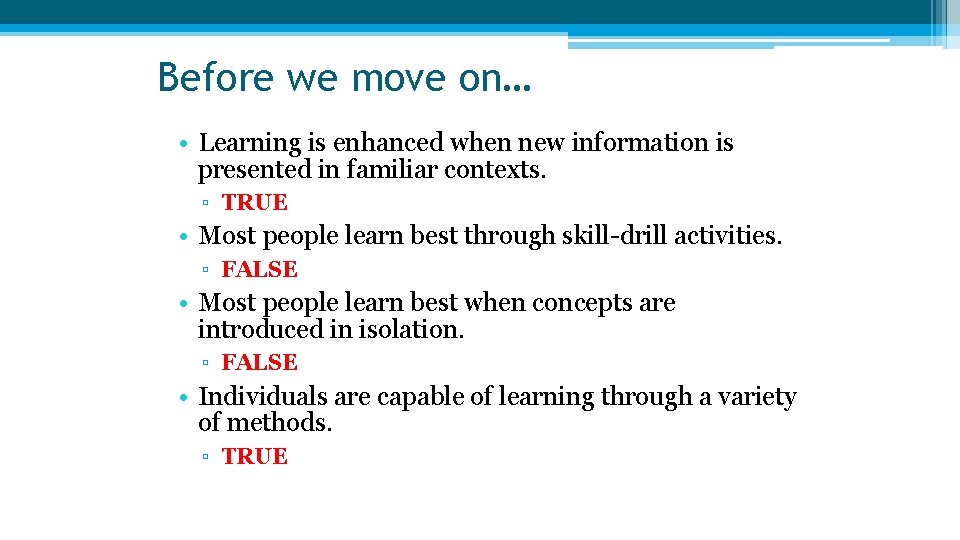
Before we move on… • Learning is enhanced when new information is presented in familiar contexts. ▫ TRUE • Most people learn best through skill-drill activities. ▫ FALSE • Most people learn best when concepts are introduced in isolation. ▫ FALSE • Individuals are capable of learning through a variety of methods. ▫ TRUE
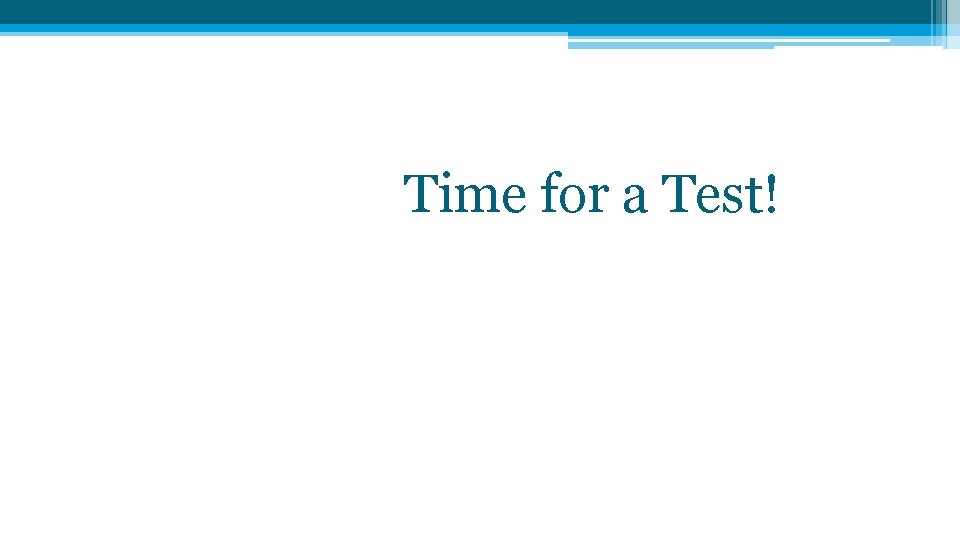
Time for a Test!
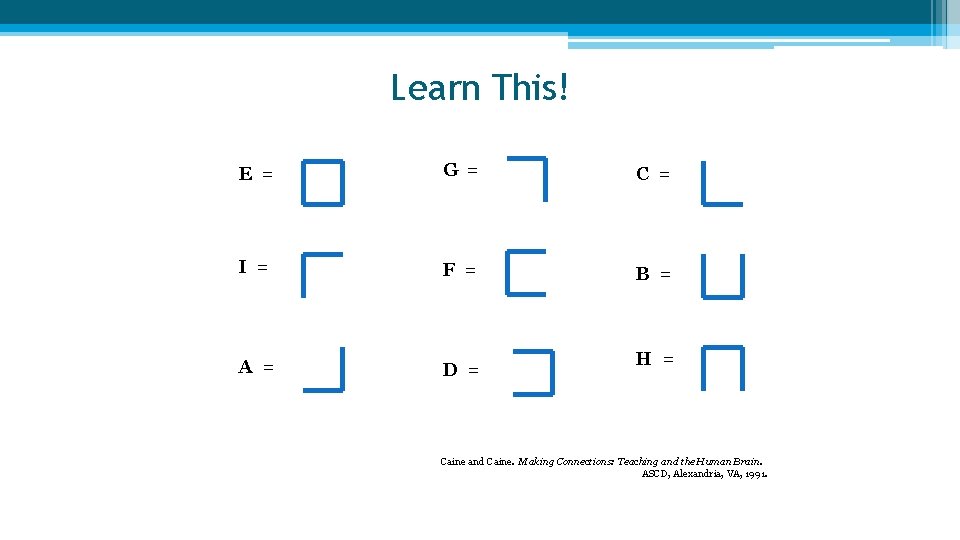
Learn This! E = G = C = I = F = B = A = D = H = Caine and Caine. Making Connections: Teaching and the Human Brain. ASCD, Alexandria, VA, 1991.
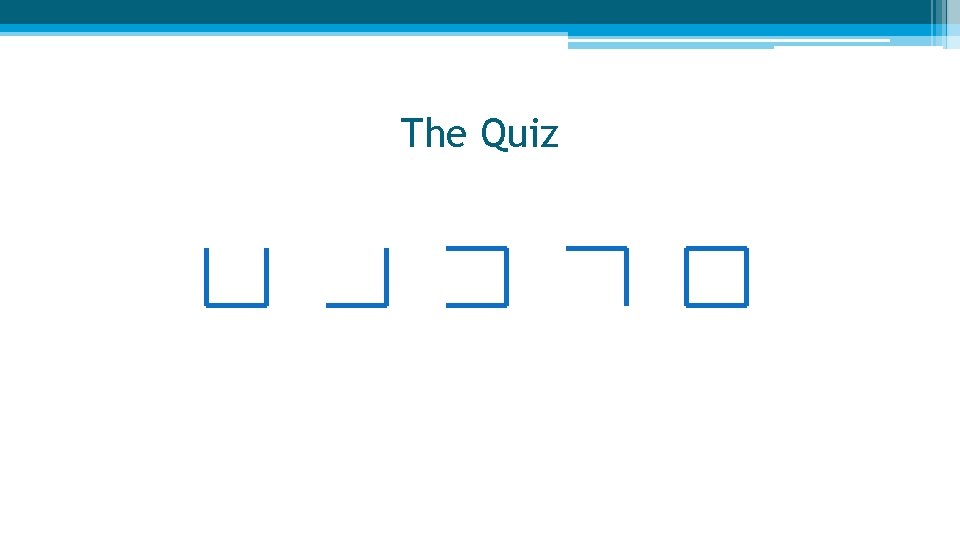
The Quiz

Here’s the Context A B C D E F G H I Caine and Caine. Making Connections: Teaching and the Human Brain. ASCD, Alexandria, VA, 1991.

Again…The Quiz A B C D E F G H I BADGE
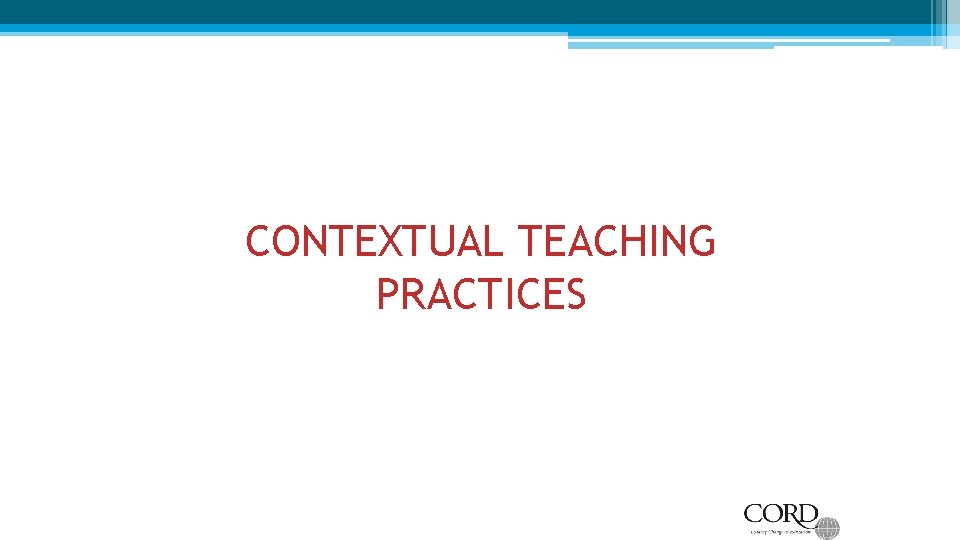
CONTEXTUAL TEACHING PRACTICES
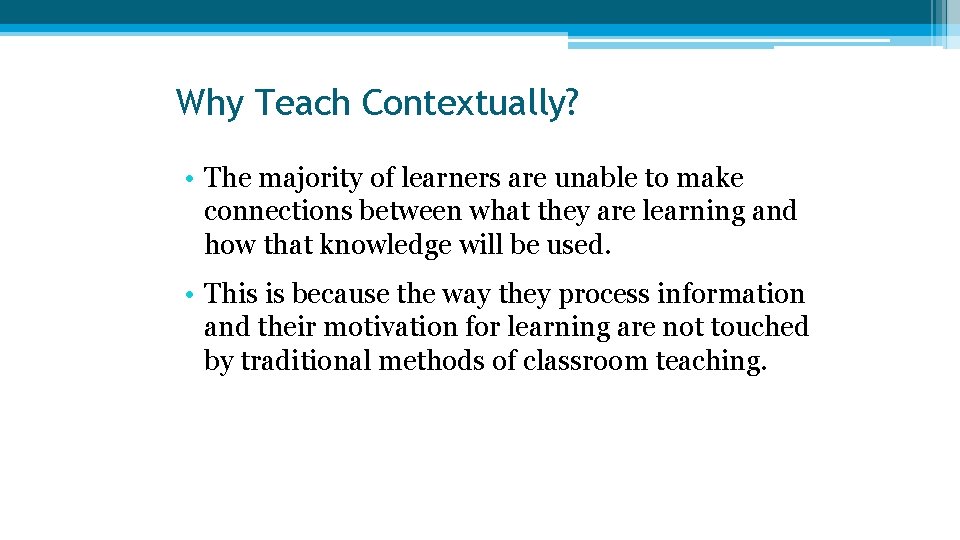
Why Teach Contextually? • The majority of learners are unable to make connections between what they are learning and how that knowledge will be used. • This is because the way they process information and their motivation for learning are not touched by traditional methods of classroom teaching.

The Contextual Approach Supports Best Practices for Reaching Adult Learners • Encourages design of learning environments that use multiple teaching modalities and incorporate different forms of learning experiences. • Allows learners to discover meaningful relationships between abstract ideas and real-world applications. • Enables concepts to be internalized through discovery, reinforcement/modeling, and problem-solving. • Provides ongoing feedback that promotes further learner interaction with content. • Engages learners and motivates them to persist.
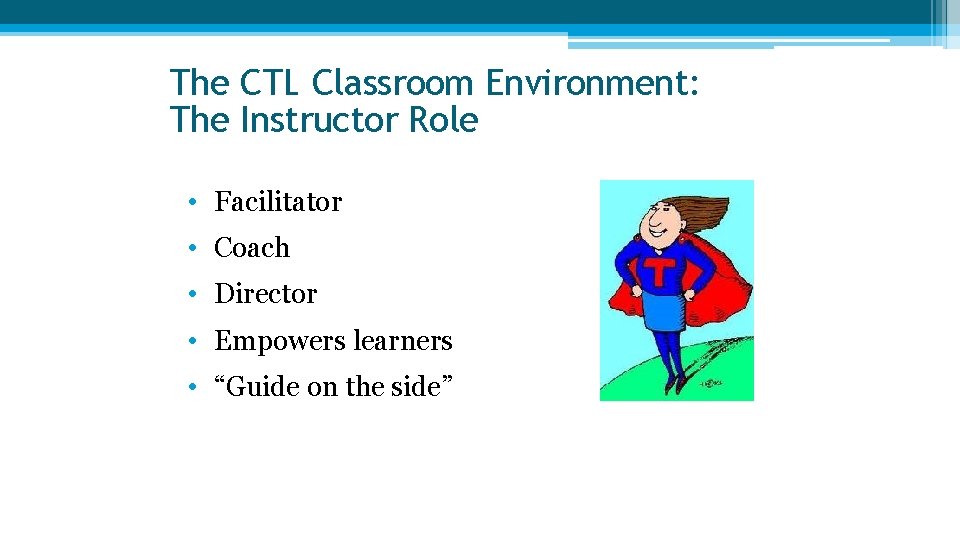
The CTL Classroom Environment: The Instructor Role • Facilitator • Coach • Director • Empowers learners • “Guide on the side”
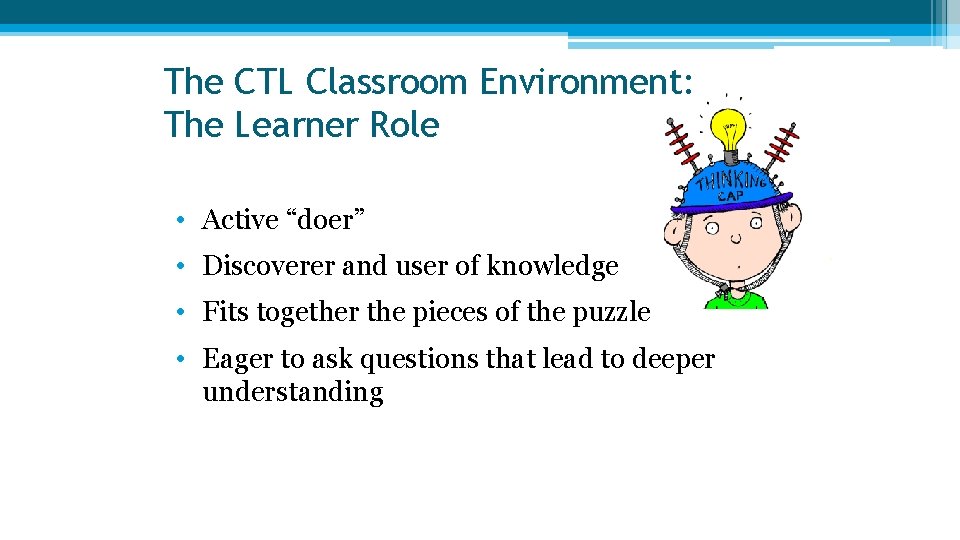
The CTL Classroom Environment: The Learner Role • Active “doer” • Discoverer and user of knowledge • Fits together the pieces of the puzzle • Eager to ask questions that lead to deeper understanding
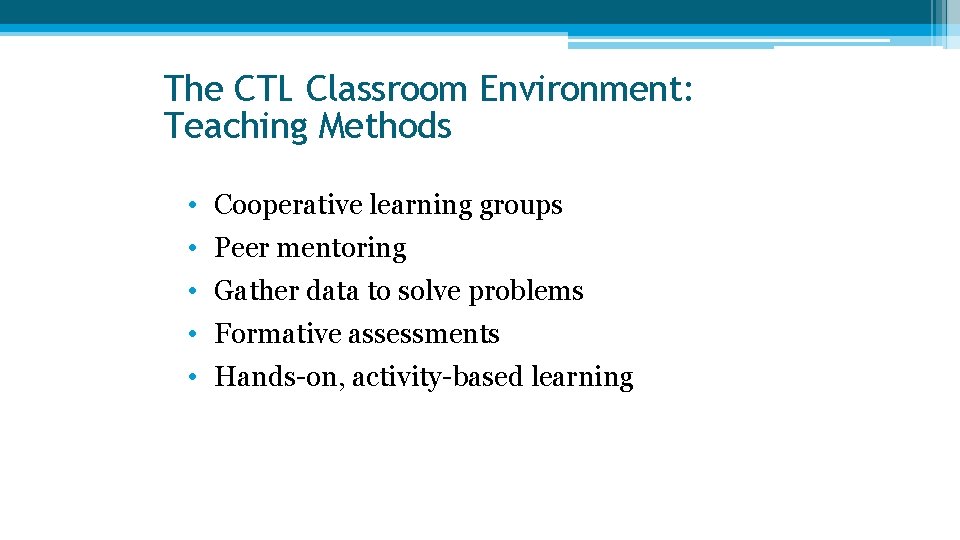
The CTL Classroom Environment: Teaching Methods • Cooperative learning groups • Peer mentoring • Gather data to solve problems • Formative assessments • Hands-on, activity-based learning
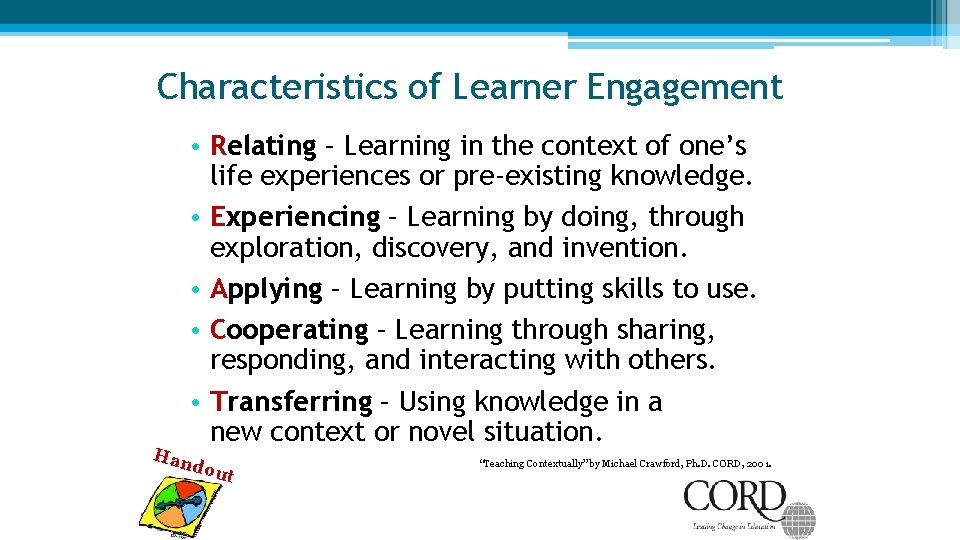
Characteristics of Learner Engagement • Relating – Learning in the context of one’s life experiences or pre-existing knowledge. • Experiencing – Learning by doing, through exploration, discovery, and invention. • Applying – Learning by putting skills to use. • Cooperating – Learning through sharing, responding, and interacting with others. • Transferring – Using knowledge in a new context or novel situation. Han dou t “Teaching Contextually” by Michael Crawford, Ph. D. CORD, 2001.
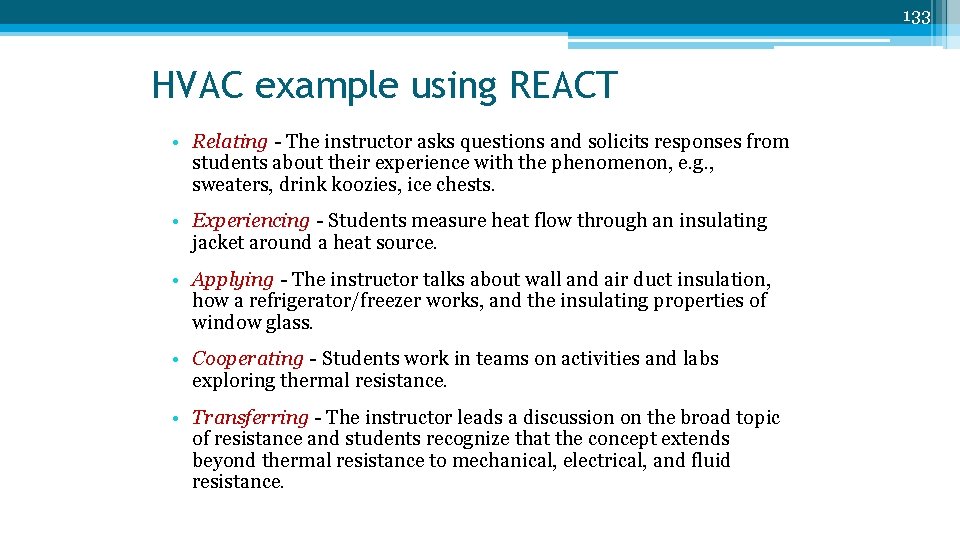
133 HVAC example using REACT • Relating - The instructor asks questions and solicits responses from students about their experience with the phenomenon, e. g. , sweaters, drink koozies, ice chests. • Experiencing - Students measure heat flow through an insulating jacket around a heat source. • Applying - The instructor talks about wall and air duct insulation, how a refrigerator/freezer works, and the insulating properties of window glass. • Cooperating - Students work in teams on activities and labs exploring thermal resistance. • Transferring - The instructor leads a discussion on the broad topic of resistance and students recognize that the concept extends beyond thermal resistance to mechanical, electrical, and fluid resistance.
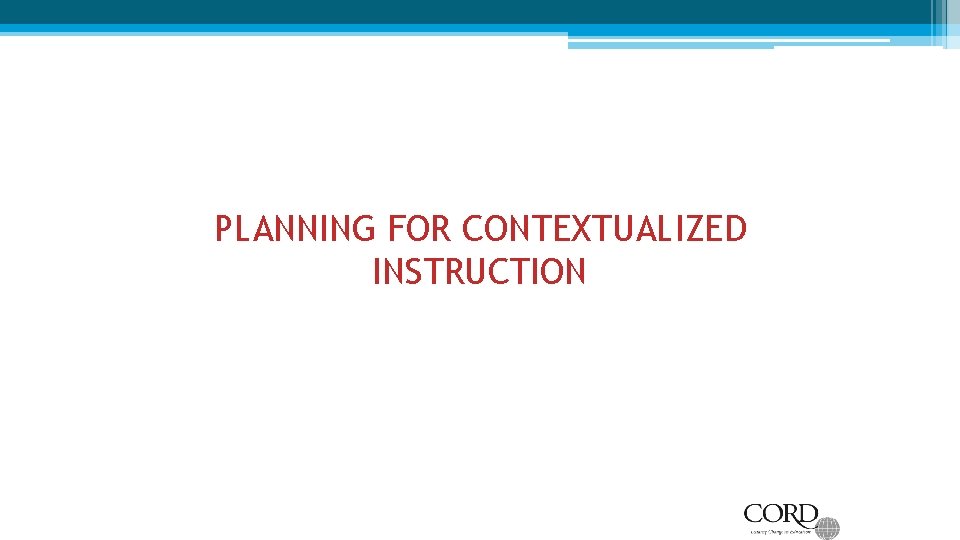
PLANNING FOR CONTEXTUALIZED INSTRUCTION
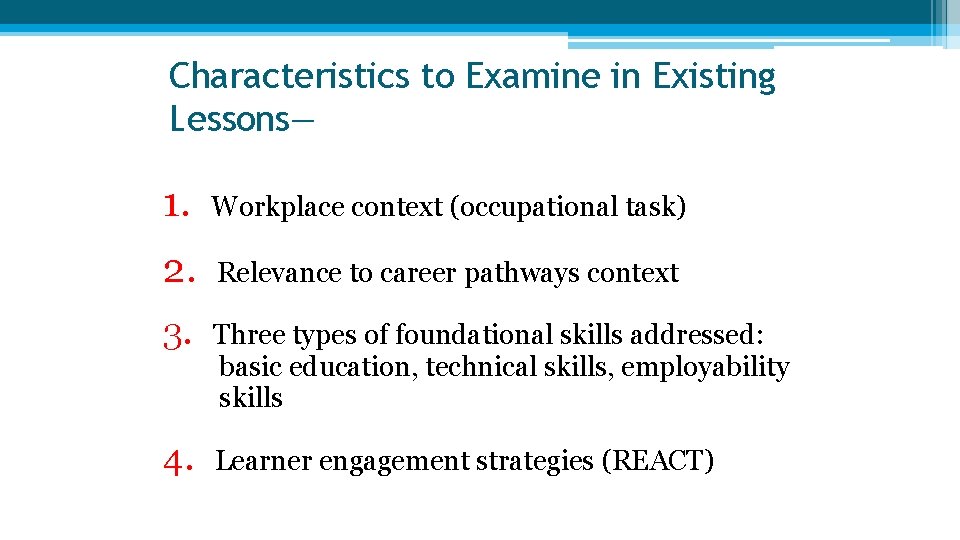
Characteristics to Examine in Existing Lessons— 1. Workplace context (occupational task) 2. Relevance to career pathways context 3. Three types of foundational skills addressed: basic education, technical skills, employability skills 4. Learner engagement strategies (REACT)
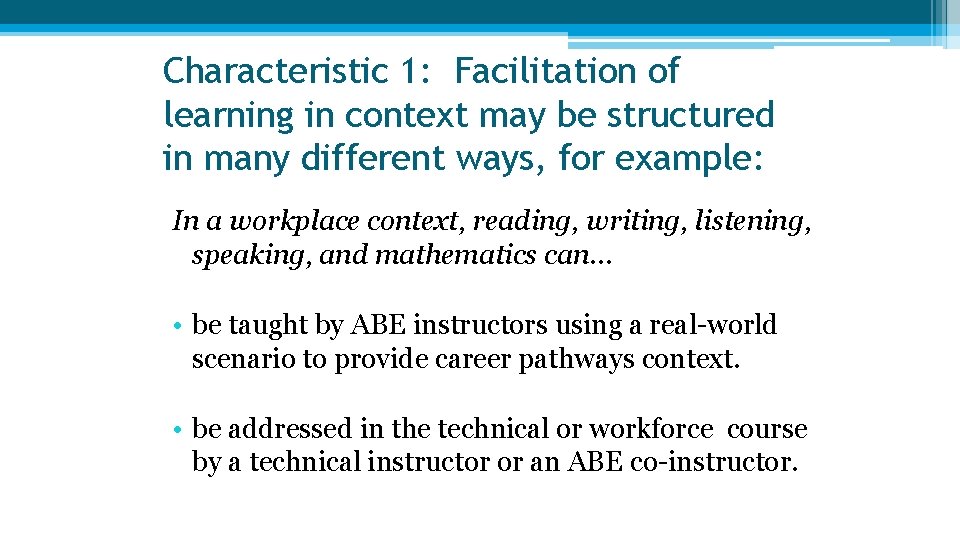
Characteristic 1: Facilitation of learning in context may be structured in many different ways, for example: In a workplace context, reading, writing, listening, speaking, and mathematics can… • be taught by ABE instructors using a real-world scenario to provide career pathways context. • be addressed in the technical or workforce course by a technical instructor or an ABE co-instructor.
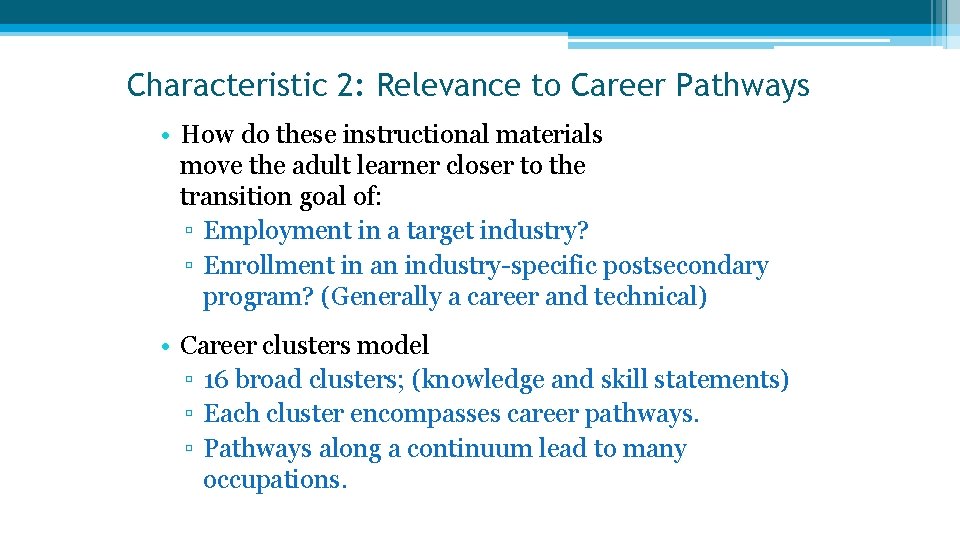
Characteristic 2: Relevance to Career Pathways • How do these instructional materials move the adult learner closer to the transition goal of: ▫ Employment in a target industry? ▫ Enrollment in an industry-specific postsecondary program? (Generally a career and technical) • Career clusters model ▫ 16 broad clusters; (knowledge and skill statements) ▫ Each cluster encompasses career pathways. ▫ Pathways along a continuum lead to many occupations.

Characteristic 3: Three Fundamental Skill Sets Three fundamental skills/competencies that apply to Adult Career Pathways instruction: A. Basic skills: reading, writing, speaking, mathematics B. Technical skills: for a career C. Employability skills: for getting and keeping a job

Characteristic 3: Three Fundamental Skill Sets A. Basic Skills Content What are the foundational basic skills content areas? ▫ Reading, Writing, Listening and Speaking, and Mathematics Where can you find information about the foundational basic skills to be taught in your adult education program? ▫ Your program administrator or instructional lead ▫ College and Career Readiness Standards for Adult Education (U. S. ED)

Characteristic 3: Three Fundamental Skill Sets B: Technical Skills • Industry-Specific Technical Skills are required for certification on the required expertise levels determined by a certifying association or organization. • Where to locate more information about required technical skills: ▫ Professional organizations or trade associations, e. g. , National Association of Manufacturers, National Restaurant Association, National Automotive Technicians Education Foundation ▫ Local employers ▫ Colleagues from technical programs ▫ Local workforce or economic development board
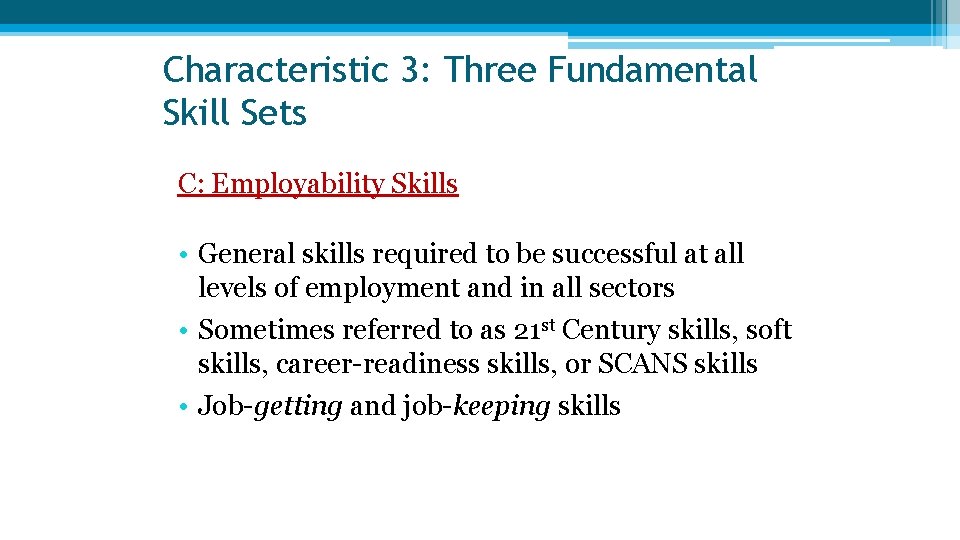
Characteristic 3: Three Fundamental Skill Sets C: Employability Skills • General skills required to be successful at all levels of employment and in all sectors • Sometimes referred to as 21 st Century skills, soft skills, career-readiness skills, or SCANS skills • Job-getting and job-keeping skills

Characteristic 4: Learner Engagement Strategies REACT strategies for learner engagement: • Relating • Experiencing • Applying • Cooperating • Transferring These are not necessarily used in a linear sequence. Not all REACT strategies may be present in a single lesson.
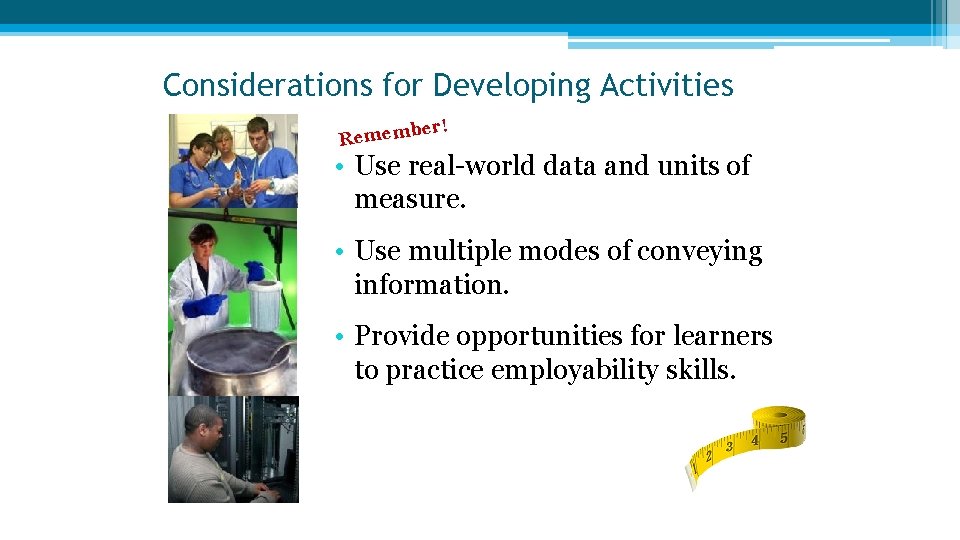
Considerations for Developing Activities er! b Remem • Use real-world data and units of measure. • Use multiple modes of conveying information. • Provide opportunities for learners to practice employability skills.
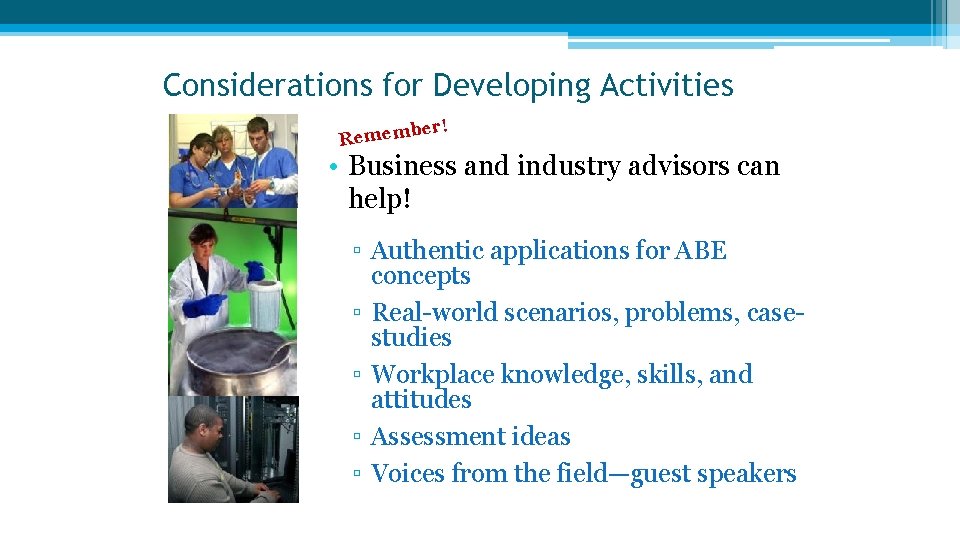
Considerations for Developing Activities er! b Remem • Business and industry advisors can help! ▫ Authentic applications for ABE concepts ▫ Real-world scenarios, problems, casestudies ▫ Workplace knowledge, skills, and attitudes ▫ Assessment ideas ▫ Voices from the field—guest speakers

Job Outlook 2019 National Association of Colleges and Employers (NACE) Top 10 Attributes Employers are Seeking in New Workers
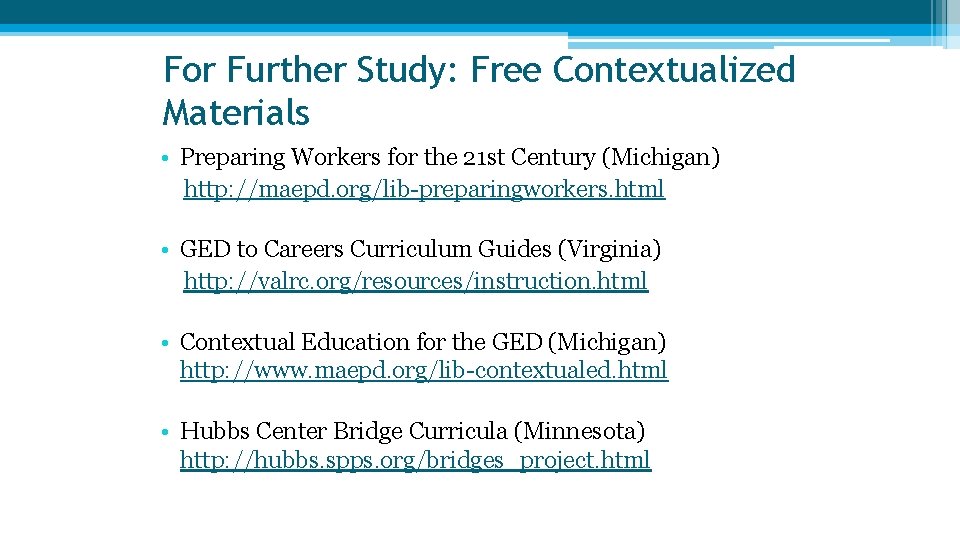
For Further Study: Free Contextualized Materials • Preparing Workers for the 21 st Century (Michigan) http: //maepd. org/lib-preparingworkers. html • GED to Careers Curriculum Guides (Virginia) http: //valrc. org/resources/instruction. html • Contextual Education for the GED (Michigan) http: //www. maepd. org/lib-contextualed. html • Hubbs Center Bridge Curricula (Minnesota) http: //hubbs. spps. org/bridges_project. html
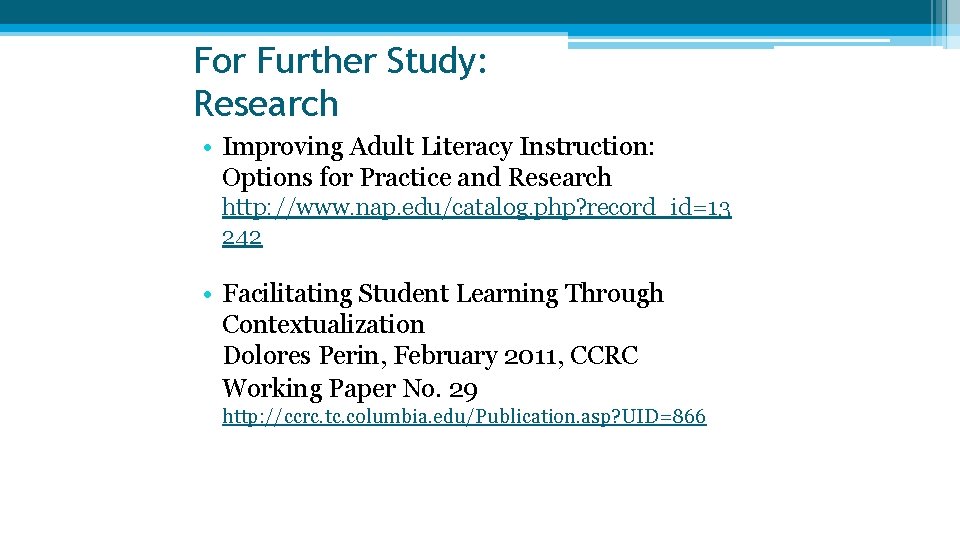
For Further Study: Research • Improving Adult Literacy Instruction: Options for Practice and Research http: //www. nap. edu/catalog. php? record_id=13 242 • Facilitating Student Learning Through Contextualization Dolores Perin, February 2011, CCRC Working Paper No. 29 http: //ccrc. tc. columbia. edu/Publication. asp? UID=866
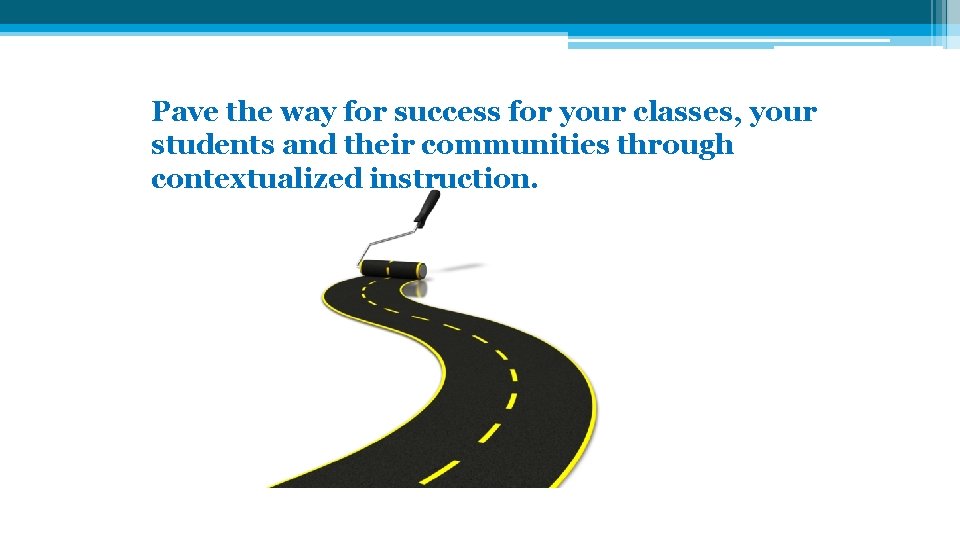
Pave the way for success for your classes, your students and their communities through contextualized instruction.

Wrap-Up

See You Tomorrow
- Slides: 148